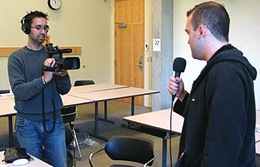
Recently, MediaShift started running reports from “embeds” at various media outlets and educational institutions. This report comes from Alfred Hermida, an assistant professor at the Graduate School of Journalism at the University of British Columbia.
Classic Hollywood movies tend to idealize the job of the reporter, from Cary Grant in “His Girl Friday” to Robert Redford and Dustin Hoffman in “All the President’s Men.” All they needed was a pen and a notebook.
Fast-forward to the 21st century and the picture changes dramatically. Not only would they need to have strong research, reporting and writing skills, the journalists would also be expected to file for the website, upload some photos, shoot video and, of course, write for next day’s paper.
The changes happening in journalism have left j-schools scrabbling to adapt to a multimedia, multi-platform news environment. At the recent annual conference in Chicago of the Association of Educators in Journalism and Mass Communication, the topic preyed on the minds of academics wondering how to cope with the technical demands of today’s journalism.
The challenges for journalism schools are two-fold. First, students need to be taught how to use a wide range of technical tools. Second, and more importantly, they have to learn how to produce real journalism using the technology. This is perhaps the hardest part.
Our students are digital natives, living in an always-on, always-connected world. The challenge in the classroom is less about teaching the technology and more about providing an understanding of how new media tools can be harnessed to create quality journalism.
The Big Disconnect
Like so many others, my j-school at the University of British Columbia has grappled with how to add a layer of technical complexity to an already packed curriculum. When I started here two years ago, I ran a course over two terms that sought to introduce students to multimedia journalism. But this approach had its own limitations. The journalism ended up taking second place in the rush to teach a wide range of technical skills. As it ran as its own separate course, there was a lack of connection to the reporting and writing skills taught in other classes.
This past year, we tried a far more integrated, holistic approach, with the technical training taking place side by side with the journalism instruction. This has allowed us to place the use of technical tools in a news context and we have found that teaching journalism and technology side by side makes a big difference.
Students learn how to, for example, record and edit audio, and then this is followed up by an assignment in which they apply these skills as a reporter. This reinforces the technical aspects but also forces students to understand how the technology can enable them to become better journalists.
However, in my experience, you have to keep stressing the connection between journalistic and technical skills. Simply creating a slideshow in Flash is not journalism. It becomes journalism when it tells a story in a powerful and evocative manner achieved through a combination of compelling images and moving audio.
Accessible Tools
Teaching journalism and technical skills side by side presents its own dilemmas. There are only so many weeks in a semester. It can be difficult to strike a balance between covering the basics of research, interviewing and writing; understanding different narrative structures; and getting the specialized skills to work across media.

The good news is that the tools used for multimedia journalism are much more accessible today than they were in the early days of the web. Back then, creating a website involved learning a program like Dreamweaver. As a result, students could spend weeks knee-deep in HTML code. While a basic grasp of HTML is still valuable, students can create websites today in minutes using hosted services such as WordPress or Blogger. This frees up valuable time in the classroom to focus on issues like information architecture and usability.
We use WordPress as a content management system in the classroom to power our course site, TheThunderbird.ca, and have found that students pick it up quickly. Tools like this are becoming more intuitive and easier to use. We welcome anything that stops the technology from getting in the way of journalism.
The added benefit of these tools is that they are often free or inexpensive. I will write in detail about the tools I have found useful in a subsequent posting. With so many choices, journalism educators are spoiled with choices. The stumbling block is not the software, but rather having instructors who can teach it. This is hardly surprising as new media didn’t exist when many professors started their careers in academia.
The result is a generational gap in both media use and understanding. Part of the answer is for instructors to go back to school themselves and pick up these new media skills. Some schools rely on bringing in professional journalists as adjuncts to handle the technical training. Others put the emphasis on students, expecting them to acquire convergence skills outside of regular class time.
I believe that the best way for professors to learn new media tools is to use them, even though this can be a time-consuming process. I suspect many academics would rather spend time on research and writing than learning to create slideshows in Flash or exploring the potential uses of Twitter in the classroom. As journalism educators, we have to be part of the media world of our students, rather than observers looking in from the outside.
Alfred Hermida is an online news pioneer and journalism educator. He is an assistant professor at the Graduate School of Journalism, the University of British Columbia, where he leads the integrated journalism program. He was a founding news editor of the BBC News website. He blogs at Reportr.net.


This may interest you:
DIGITAL MEDIA AND LEARNING COMPETITION 2008
Digital Media and Learning Competition 2008
Focus: Participatory Learning
Application Deadline: October 15, 2008
Full information at: http://www.dmlcompetition.net
Application Deadline: October 15, 2008
The second HASTAC/MacArthur Digital Media and Learning Competition is now open! The focus is participatory learning.
Awards will be made in two categories:
Innovation in Participatory Learning Awards support large-scale digital learning projects
$30,000-$250,000
Young Innovator Awards are targeted at 18-25 year olds
$5,000-$30,000
Full information at: http://www.dmlcompetition.net
Thanks for the information and link, Sara. It looks like a promising initiative.